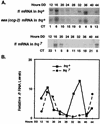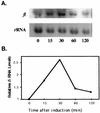Distinct signaling pathways from the circadian clock participate in regulation of rhythmic conidiospore development in Neurospora crassa
- PMID: 12455961
- PMCID: PMC118037
- DOI: 10.1128/EC.1.2.273-280.2002
Distinct signaling pathways from the circadian clock participate in regulation of rhythmic conidiospore development in Neurospora crassa
Abstract
Several different environmental signals can induce asexual spore development (conidiation) and expression of developmentally regulated genes in Neurospora crassa. However, under constant conditions, where no environmental cues for conidiation are present, the endogenous circadian clock in N. crassa promotes daily rhythms in expression of known developmental genes and of conidiation. We anticipated that the same pathway of gene regulation would be followed during clock-controlled conidiation and environmental induction of conidiation and that the circadian clock would need only to control the initial developmental switch. Previous experiments showed that high-level developmental induction of the clock-controlled genes eas (ccg-2) and ccg-1 requires the developmental regulatory proteins FL and ACON-2, respectively, and normal developmental induction of fl mRNA expression requires ACON-2. We demonstrate that the circadian clock regulates rhythmic fl gene expression and that fl rhythmicity requires ACON-2. However, we find that clock regulation of eas (ccg-2) is normal in an fl mutant strain and ccg-1 expression is rhythmic in an acon-2 mutant strain. Together, these data point to the endogenous clock and the environment following separate pathways to regulate conidiation-specific gene expression.
Figures






Similar articles
-
The Neurospora circadian clock regulates a transcription factor that controls rhythmic expression of the output eas(ccg-2) gene.Mol Microbiol. 2001 Aug;41(4):897-909. doi: 10.1046/j.1365-2958.2001.02558.x. Mol Microbiol. 2001. PMID: 11532152
-
The Neurospora circadian clock-controlled gene, ccg-2, is allelic to eas and encodes a fungal hydrophobin required for formation of the conidial rodlet layer.Genes Dev. 1992 Dec;6(12A):2382-94. doi: 10.1101/gad.6.12a.2382. Genes Dev. 1992. PMID: 1459460
-
Neurospora clock-controlled gene 9 (ccg-9) encodes trehalose synthase: circadian regulation of stress responses and development.Eukaryot Cell. 2002 Feb;1(1):33-43. doi: 10.1128/EC.1.1.33-43.2002. Eukaryot Cell. 2002. PMID: 12455969 Free PMC article.
-
Conidiation in Neurospora crassa: vegetative reproduction by a model fungus.Int Microbiol. 2020 Jan;23(1):97-105. doi: 10.1007/s10123-019-00085-1. Epub 2019 Jun 6. Int Microbiol. 2020. PMID: 31172300 Review.
-
Circadian entrainment of Neurospora crassa.Cold Spring Harb Symp Quant Biol. 2007;72:279-85. doi: 10.1101/sqb.2007.72.032. Cold Spring Harb Symp Quant Biol. 2007. PMID: 18419284 Review.
Cited by
-
Systems biology of the clock in Neurospora crassa.PLoS One. 2008 Aug 29;3(8):e3105. doi: 10.1371/journal.pone.0003105. PLoS One. 2008. PMID: 18769678 Free PMC article.
-
Regulation by blue light of the fluffy gene encoding a major regulator of conidiation in Neurospora crassa.Genetics. 2010 Mar;184(3):651-8. doi: 10.1534/genetics.109.109975. Epub 2009 Dec 21. Genetics. 2010. PMID: 20026679 Free PMC article.
-
Circadian rhythmicity mediated by temporal regulation of the activity of p38 MAPK.Proc Natl Acad Sci U S A. 2007 Nov 13;104(46):18223-8. doi: 10.1073/pnas.0704900104. Epub 2007 Nov 5. Proc Natl Acad Sci U S A. 2007. PMID: 17984065 Free PMC article.
-
The band mutation in Neurospora crassa is a dominant allele of ras-1 implicating RAS signaling in circadian output.Genes Dev. 2007 Jun 15;21(12):1494-505. doi: 10.1101/gad.1551707. Genes Dev. 2007. PMID: 17575051 Free PMC article.
-
Circadian output, input, and intracellular oscillators: insights into the circadian systems of single cells.Cold Spring Harb Symp Quant Biol. 2007;72:201-14. doi: 10.1101/sqb.2007.72.067. Cold Spring Harb Symp Quant Biol. 2007. PMID: 18419278 Free PMC article. Review.
References
-
- Aronson, B. D., K. A. Johnson, J. J. Loros, and J. C. Dunlap. 1994. Negative feedback defining a circadian clock: autoregulation in the clock gene frequency. Science 263:1578-1584. - PubMed
Publication types
MeSH terms
Grants and funding
LinkOut - more resources
Full Text Sources

